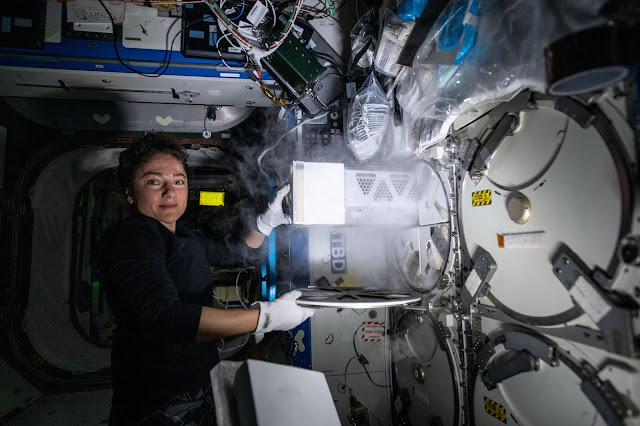ISS - Expedition 62 Mission patch.
April 10, 2020
Scientific investigations under way aboard the International Space Station the week of April 6 included studies of bone loss and medical software. On Tuesday, the SpaceX 20 Dragon cargo craft departed the station and brought samples, hardware and data from completed investigations back to Earth. Thursday, Russia’s Soyuz MS-16 crew ship blasted off from Kazakhstan carrying new crew members NASA astronaut Chris Cassidy and Roscosmos cosmonauts Anatoly Ivanishin and Ivan Vagner to a 195-day mission on the space station.
Image above: NASA astronaut Jessica Meir gathers frozen research samples stowed in a space station science freezer before loading them into the SpaceX Dragon resupply ship to return to Earth for scientific analysis. Image Credit: NASA.
Now in its 20th year of continuous human presence, the space station provides a platform for long-duration research in microgravity and for learning to live and work in space. Experience gained on the orbiting lab supports Artemis, NASA’s program to go forward to the Moon and on to Mars.
Here are details on some of the microgravity investigations currently taking place:
Packed for return to Earth
Before Dragon’s departure on Tuesday, crew members finished packing scientific samples to return to the ground for further analysis and reporting of results. Returning samples included those from Microgravity Crystallization of Glycogen Synthase-Glycogenin (CASIS PCG 10), Generation of Cardiomyocytes From Human Induced Pluripotent Stem Cell-derived Cardiac Progenitors Expanded in Microgravity (MVP2 Cell-03) and Space Cells-01. CASIS PCG 10 grew crystals of two human glycogen synthase proteins in microgravity to support the discovery of treatments for obesity, rare glycogen storage disorders and potentially cancer. MVP2 Cell-03 examines whether microgravity increases the production of specialized heart cells called cardiomyocytes, which might make it possible to replenish cells damaged or lost due to cardiac disease. Space Cells-01, which examines genetic changes in hemp and coffee plant cells in microgravity, could help improve understanding of how plants manage the stress of space travel.
Image above: Hardware for the Flow Chemistry Platform for Synthetic Reactions on ISS, an investigation that studies the effects of microgravity on synthetic chemical reactions as a step toward on-demand production of chemicals and materials in space. Image Credit: NASA.
The crew also packed samples from OsteoOmics, an investigation into whether magnetic levitation accurately simulates microgravity by comparing genetic expression in bone cells levitated in a high-field superconducting magnet with cells that flew on the space station.
The electronic doctor will see you now
As missions venture farther from Earth, astronauts need to be able to diagnose and treat acute medical conditions on their own. The Autonomous Medical Officer Support Software Demonstration (AMOS Demonstration) tests a software tool that helps minimally trained or even untrained users conduct complicated medical procedures without assistance from Earth. The AMOS platform is part of a novel approach to training and skill management that uses the same product for all phases of missions and also could support operations in remote or austere environments on Earth. Examples include providing medical and military personnel with increased levels of autonomy and supporting engineering or maintenance operations in regions with poor or nonexistent communication, including disaster sites. During the week, the crew prepared for a session using ultrasound to image the urinary bladder and kidneys, a plausible medical scenario on a Mars mission.
Want fries with that?
Food Acceptability examines the effect of repetitive consumption of the somewhat limited selection of foods available during spaceflight. “Menu fatigue” resulting from this limited choice may, over time, contribute to the loss of body mass often experienced by crew members. Menu fatigue has the potential to affect astronaut health, especially as mission length increases. This effect may become more severe as mission length increases, and this investigation can help improve the design of current food systems and those on future exploration missions. During the week, crew members completed questionnaires for the investigation.
Other investigations on which the crew performed work:
Image above: Plants in the Veggie PONDS unit, which uses a passive nutrient delivery system and the station’s Veggie plant growth facility to cultivate lettuce and mizuna greens for harvest on-orbit. Image Credit: NASA.
- Veggie PONDS (Passive Orbital Nutrient Delivery System) cultivates lettuce and mizuna greens that are harvested on-orbit for consumption and scientific analysis.
https://www.nasa.gov/mission_pages/station/research/experiments/explorer/Investigation.html?#id=7581
- Flow Chemistry Platform for Synthetic Reactions on ISS studies the effects of microgravity on synthetic chemical reactions as a step toward on-demand production of chemicals and materials in space and on Earth.
https://www.nasa.gov/mission_pages/station/research/experiments/explorer/Investigation.html?#id=8172
The ESA (European Space Agency) AstroPi Challenge offers students and other young people the opportunity to conduct scientific investigations in space by writing- computer programs or code for the space station’s two Raspberry Pi computers, with either 'Life in Space' or 'Life on Earth' as themes for their experiments.
https://www.nasa.gov/mission_pages/station/research/experiments/explorer/Investigation.html?#id=7534
- The Japan Aerospace Exploration Agency (JAXA) Mouse Habitat Unit-5 (MHU-5) investigation examines the effects of partial gravity on gene expression in mice using the Centrifuge-equipped Biological Experiment Facility-L (CBEF-L) developed by JAXA.
https://www.nasa.gov/mission_pages/station/research/experiments/explorer/Investigation.html?#id=8150
https://www.nasa.gov/mission_pages/station/research/experiments/explorer/Facility.html?#id=7697
- ActiWatch is a wrist device worn by crew members that contains an accelerometer to measure motion and a detector to monitor ambient lighting. The device analyzes circadian rhythms, sleep-wake patterns, and activity.
https://www.nasa.gov/mission_pages/station/research/experiments/explorer/Facility.html?#id=838
- Standard Measures captures an ongoing, optimized set of measures from crew members to characterize how their bodies adapt to living in space. Researchers use these measures to create a data repository for high-level monitoring of the effectiveness of countermeasures and better interpretation of health and performance outcomes.
https://www.nasa.gov/mission_pages/station/research/experiments/explorer/Investigation.html?#id=7711
Space to Ground: Departing Baikonur: 04/10/2020
Related links:
Expedition 62: https://www.nasa.gov/mission_pages/station/expeditions/expedition62/index.html
Expedition 63: https://www.nasa.gov/mission_pages/station/expeditions/expedition63/index.html
CASIS PCG 10: https://www.nasa.gov/mission_pages/station/research/experiments/explorer/Investigation.html?#id=7628
MVP2 Cell-03: https://www.nasa.gov/mission_pages/station/research/experiments/explorer/Investigation.html?#id=7725
Space Cells-01: https://www.nasa.gov/mission_pages/station/research/experiments/explorer/Investigation.html?#id=8223
OsteoOmics: https://www.nasa.gov/mission_pages/station/research/experiments/explorer/Investigation.html?#id=1149
AMOS Demonstration: https://www.nasa.gov/mission_pages/station/research/experiments/explorer/Investigation.html?#id=8173
Food Acceptability: https://www.nasa.gov/mission_pages/station/research/experiments/explorer/Investigation.html?#id=7562
ISS National Lab: https://www.issnationallab.org/
Spot the Station: https://spotthestation.nasa.gov/
Space Station Research and Technology: https://www.nasa.gov/mission_pages/station/research/index.html
International Space Station (ISS): https://www.nasa.gov/mission_pages/station/main/index.html
Images (mentioned), Video (NASA), Text, Credits: NASA/Michael Johnson/John Love, Lead Increment Scientist Expedition 62.
Best regards, Orbiter.ch




